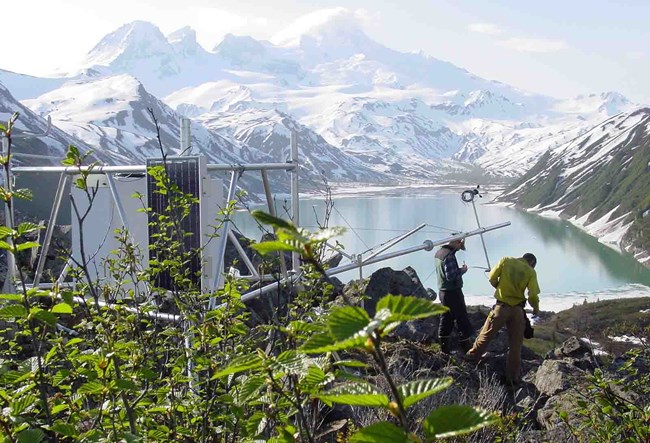
Weather and climate are key physical drivers of ecosystem structure and function. Because global climate models indicate that climate change and variability will be greatest at high latitudes, climate monitoring is critical to understanding the changing conditions of park ecosystems. Some potential effects in Southwest Alaska parklands include a reduced snowpack, earlier lake-ice breakup, warmer winters, and wetter summers. These changes will likely affect the distribution, abundance, growth, and productivity of plants and animals.
Long-term climate records are critically important for understanding responses of vital signs selected as important indicators of resource condition in the Southwest Alaska parklands. For example, precipitation and air temperature drive stream discharge (surface hydrology) which directly affects water quality conditions (freshwater chemistry). Weather patterns strongly influence patterns of marine productivity, marine food web dynamics, and the survival and recruitment dynamics of predator and prey populations.
A series of weather stations are operated at locations representative of the climatic gradients present in Southwest Alaska parks. Research-grade meteorological instrumentation is used to collect weather data. The standard sensor array includes: air temperature (rated to -60°C), relative humidity, rain gauge (for summer rainfall), ultrasonic snow depth sensor, pyranometer for incoming solar radiation, wind speed and wind direction, and soil temperature probes (10, 20, and 50 cm depths). Some sites also have sensors to record soil moisture, soil matric potential, and up- and down-welling long- and short-wave radiation. Data are continuously recorded on an hourly interval and stored within the datalogger on site and transmitted via satellite in near real-time.
The goal of the weather and climate monitoring program is to record weather conditions at representative locations in order to quantify one of the drivers in Alaska’s ecosystems, identify long- and short-term trends, provide reliable climate data to other researchers, and to participate in larger-scale climate monitoring and modeling efforts. Specifically, our objectives are to:
-
Record and archive hourly weather observations of temperature, relative humidity, precipitation, wind speed and direction, solar radiation, snow depth,and soil temperature at weather stations located across climatic gradients in Southwest Alaska parklands.
-
Provide high-quality, real-time, and long-term archived data of weather observations and produce summaries of climatic conditions.
We monitor weather and climate in all Southwest Alaska Network parks.
See new PRISM data. Average monthly and annual precipitation and minimum, maximum, and mean termperature data for the period of 1981-2018 are available for the state of Alaska. The PRISM (Parameter-elevation Regressions on Independent Slopes Model) climate mapping system integrates existing climate station data with scientific understanding of general climate processes and local climate features.
- Duration:
- 3 minutes, 43 seconds
Wet snow and the icing events that frequently follow wintertime rain-on-snow (ROS) affect high-latitude ecosystems at multiple spatial and temporal scales, including hydrology, carbon cycle, wildlife, and human development. This video shows the extent and timing of ROS across Alaska.
Learn more
Last updated: December 8, 2025
